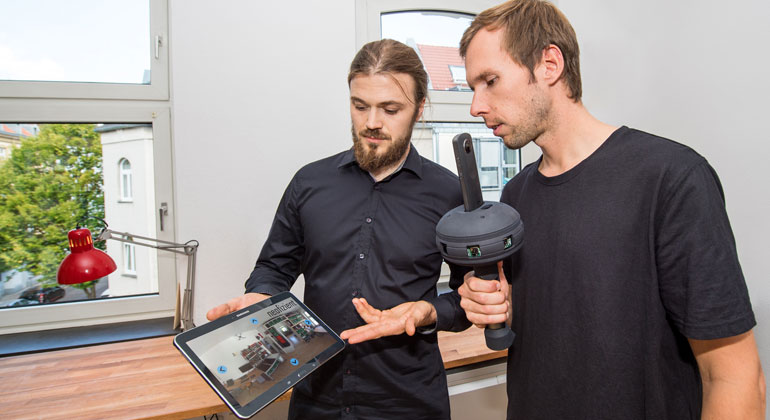The automated energy consultant
An innovative measurement system for more cost-effective building energy analyses
Around 400,000 residential units are refurbished in Germany each year, including apartments, family homes and apartment buildings. The German Energy Agency (dena) attributes a crucial role to these energy saving refurbishments in order to achieve the climate targets. The reason is that most of the roughly 18 million residential buildings in Germany were built before the first thermal insulation regulation came into force in 1978 and are therefore insufficiently energy-efficient. Energy saving refurbishments are preceded by building energy consultations. But until now, these have been virtually incomparable as they greatly depend on the quality of the individual consultant. Competent consulting is often expensive, often reaching four-figure sums.
The DLR spin-off ‘neofizient’ has now developed a measurement system that records and automatically analyses energy efficiency information about buildings. “Our algorithm is designed to make consultancy more objective, faster and simpler – and therefore also less expensive,” says Silvan Siegrist, who is responsible for the project together with Arne Tiddens. They will jointly manage neofizient when the spin-off project is established as an independent enterprise in early 2019.
Pictures and infrared images are superimposed in a model
Their invention is based on cameras that take 360-degree photographs of a room in the visible and infrared. The data is used to create a 2.5 dimensional model of the room, which shows the ceiling, walls and floor in three dimensions, but saves on computing power by refraining from the realistic insertion of decorative objects such as furniture and plants. The cameras then superimpose infrared images of the room within the model in order to visualise information that is relevant to energy efficiency.
Even beginners can operate the measurement system and evaluate the results
The heat transfer coefficient is of particular interest to renovators, as it indicates how much energy is lost and where. For example, conclusions can be drawn from the data on where thermal bridges interrupt the building’s heat insulation. They may include steel girders protruding through a wall, poorly insulated window frames or damp in the walls. This data can then be used by developers, energy consultants or builders. “The measurement system should be cheap enough to rent and sufficiently simple to operate so that it can be used by laymen,” says Silvan Siegrist. The two scientists from the DLR Institute of Solar Research in Cologne plan to launch their measurement system in spring 2019. By the end of 2019, they will receive around 250,000 euro in funding from the Helmholtz Enterprise programme among others. Each year, the Helmholtz Association uses this programme to promote the most promising business ideas from its institutes in order to enable successful spin-offs to become independent companies and hence to speed up the introduction of technological progress into everyday life.
In September 2018, the DLR spin-off was also selected for funding within the Climate-KIC (Knowledge and Innovation Community) initiative by the European Institute of Innovation & Technology (EIT). As the most important EU-funding initiative, Climate-KIC supports start-ups that are able to contribute to a carbon-neutral economy. The companies receive up to 95,000 euro in support, in addition to considerable consultancy services.
neofizient already has its sights set on further developing its ideas: “We want to improve the software in future so that it will be able to make recommendations for energy-efficient refurbishments,” says Siegrist. This would be the first automated energy consultant. But when it will actually commence operations is currently unknown.








